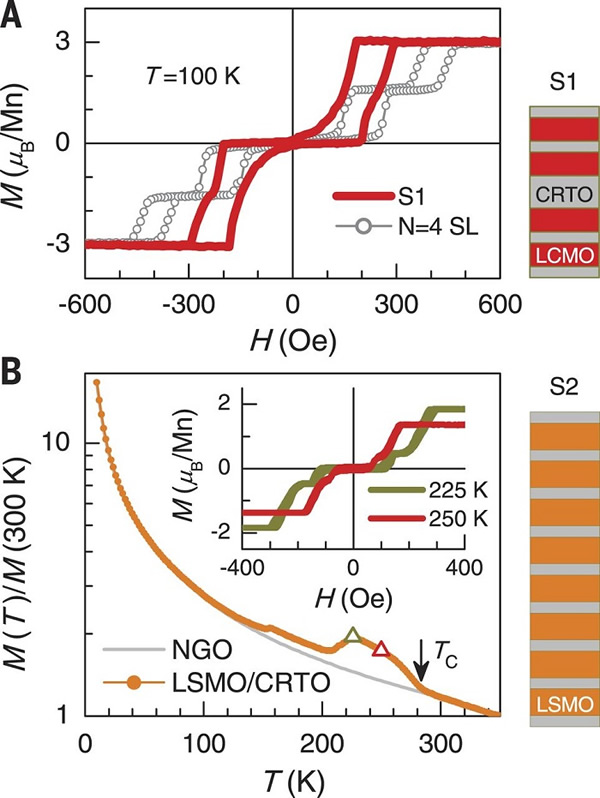Chinese and German scientists have made important breakthroughs in the field of oxide spintronics recently. For the first time, artificial antiferromagnets based on all-oxide epitaxy systems have been prepared, and step-by-step magnetization and flip patterns with external magnetic fields have been observed. The results were published in the recent "Science" magazine. Artificial antiferromagnets are not only an important part of many new types of spintronic devices (such as magnetic random access memories), but also are important carriers for the study of fundamental issues of antiferromagnetic materials.

AF-IEC in LCMO/CRTO multilayers. [via ScienceMag.org]
In the late 1980s, the discovery of the giant magnetoresistance effect in artificial antiferromagnets led to the birth of spintronics, and it was precisely because of its successful application in commercial magnetic storage and other fields that made cloud storage and clouds today. New industries such as computing are possible. For a long time, research on artificial antiferromagnet materials, physics and devices has focused on transition metals and their alloy materials. However, successful preparation of full-oxide antiferromagnets has rarely been reported.

Dependence of IEC on layer thicknesses.
The latest research was mainly completed by Prof. Wu Wenbin’s team at the Hefei National Laboratory for Microscale Physical Sciences at the China University of Science and Technology. They discovered a clear antiferromagnetic interlayer exchange coupling effect in the prepared antiferromagnets. It was observed for the first time from the surface and the interior. The step-by-step magnetization flip mode of each magnetic layer gives the variation law of coupling strength with each layer thickness and temperature, and possible coupling mechanism. Su Yixi, a researcher at the Ulrich Research Center in Germany, used Munich's high-flux neutron reactor and related high-sensitivity neutron spectrometer tests to verify the anti-ferromagnetic coupling of artificial anti-ferromagnets in this full oxide epitaxy system. .

Temperature-dependent magnetization reversal in LCMO/CRTO SL.
This work will play an important role in promoting the development of oxide spintronics, and it will provide a new platform and thought for further exploration of the functional oxide interface. "Science" magazine evaluates this research result, saying that this is a very high level of experimental work. Its research is very skillful in terms of sample quality and characterization. The results are very interesting and potentially open up other oxide multilayer films. New research direction.

Variations on the AF-IEC system based on the CRTO spacer.
It is reported that this research has been funded by the National Natural Science Foundation of China, the National Key Basic Research Development Plan, and the Hefei University Science Center. (Reporter Gu Gang)
Pressure sensor usually consists of a pressure sensor and a signal processing unit for measuring the pressure of liquids and gases. According to different test pressure types, pressure sensors can be divided into gauge pressure sensors, differential pressure sensors and absolute pressure sensors. According to the working principle, it can be divided into Ceramic Pressure Sensor, diffusion silicon pressure sensor, piezoresistive pressure sensor, sapphire pressure sensor and so on.
Pressure Sensor,Miniature Pressure Transducer,Pressure Transducer,Hydraulic Pressure Transducer,pressure transmitter
Xi'an Gavin Electronic Technology Co., Ltd , https://www.gamicos-meas.com